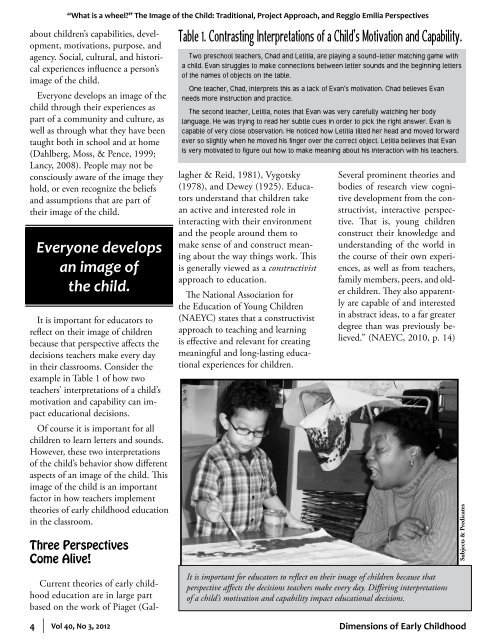Volume 40, Number 3, 2012 Traditional, Project, Reggio ° Family ...
Volume 40, Number 3, 2012 Traditional, Project, Reggio ° Family ...
Volume 40, Number 3, 2012 Traditional, Project, Reggio ° Family ...
You also want an ePaper? Increase the reach of your titles
YUMPU automatically turns print PDFs into web optimized ePapers that Google loves.
“What is a wheel?” The Image of the Child: <strong>Traditional</strong>, <strong>Project</strong> Approach, and <strong>Reggio</strong> Emilia Perspectives<br />
about children’s capabilities, development,<br />
motivations, purpose, and<br />
agency. Social, cultural, and historical<br />
experiences influence a person’s<br />
image of the child.<br />
Everyone develops an image of the<br />
child through their experiences as<br />
part of a community and culture, as<br />
well as through what they have been<br />
taught both in school and at home<br />
(Dahlberg, Moss, & Pence, 1999;<br />
Lancy, 2008). People may not be<br />
consciously aware of the image they<br />
hold, or even recognize the beliefs<br />
and assumptions that are part of<br />
their image of the child.<br />
Everyone develops<br />
an image of<br />
the child.<br />
It is important for educators to<br />
reflect on their image of children<br />
because that perspective affects the<br />
decisions teachers make every day<br />
in their classrooms. Consider the<br />
example in Table 1 of how two<br />
teachers’ interpretations of a child’s<br />
motivation and capability can impact<br />
educational decisions.<br />
Of course it is important for all<br />
children to learn letters and sounds.<br />
However, these two interpretations<br />
of the child’s behavior show different<br />
aspects of an image of the child. This<br />
image of the child is an important<br />
factor in how teachers implement<br />
theories of early childhood education<br />
in the classroom.<br />
Three Perspectives<br />
Come Alive!<br />
Table 1. Contrasting Interpretations of a Child’s Motivation and Capability.<br />
Two preschool teachers, Chad and Letitia, are playing a sound-letter matching game with<br />
a child. Evan struggles to make connections between letter sounds and the beginning letters<br />
of the names of objects on the table.<br />
One teacher, Chad, interprets this as a lack of Evan’s motivation. Chad believes Evan<br />
needs more instruction and practice.<br />
The second teacher, Letitia, notes that Evan was very carefully watching her body<br />
language. He was trying to read her subtle cues in order to pick the right answer. Evan is<br />
capable of very close observation. He noticed how Letitia tilted her head and moved forward<br />
ever so slightly when he moved his finger over the correct object. Letitia believes that Evan<br />
is very motivated to figure out how to make meaning about his interaction with his teachers.<br />
Current theories of early childhood<br />
education are in large part<br />
based on the work of Piaget (Gallagher<br />
& Reid, 1981), Vygotsky<br />
(1978), and Dewey (1925). Educators<br />
understand that children take<br />
an active and interested role in<br />
interacting with their environment<br />
and the people around them to<br />
make sense of and construct meaning<br />
about the way things work. This<br />
is generally viewed as a constructivist<br />
approach to education.<br />
The National Association for<br />
the Education of Young Children<br />
(NAEYC) states that a constructivist<br />
approach to teaching and learning<br />
is effective and relevant for creating<br />
meaningful and long-lasting educational<br />
experiences for children.<br />
Several prominent theories and<br />
bodies of research view cognitive<br />
development from the constructivist,<br />
interactive perspective.<br />
That is, young children<br />
construct their knowledge and<br />
understanding of the world in<br />
the course of their own experiences,<br />
as well as from teachers,<br />
family members, peers, and older<br />
children. They also apparently<br />
are capable of and interested<br />
in abstract ideas, to a far greater<br />
degree than was previously believed.”<br />
(NAEYC, 2010, p. 14)<br />
Subjects & Predicates<br />
4 Vol <strong>40</strong>, No 3, <strong>2012</strong><br />
It is important for educators to reflect on their image of children because that<br />
perspective affects the decisions teachers make every day. Differing interpretations<br />
of a child’s motivation and capability impact educational decisions.<br />
Dimensions of Early Childhood
















